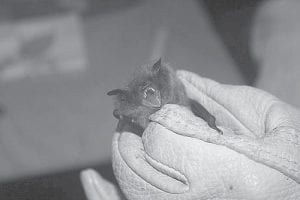U.S. Senator Amy Klobuchar (D-Minn) and Kelly Ayotte (R-NH), recently joined forces to ask the U.S. Fish and Wildlife Service (USFWS) to minimize the economic impacts of its potential decision to add the northern long-eared (NLEB) bat to the Endangered Species List (ESL).
Since 2006 a fungus that grows in caves or mines where bats hibernate has caused whitenosed syndrome, which has killed millions of bats. White-nose syndrome is currently found in 17 of the 39 states that constitute the northern long eared bat’s range.
The senators asked the USFWS to use a special Endangered Species Act (ESA) rule to help manage the bat.
“White nose syndrome is having a devastating effect on the nation’s bat populations, which play a vital role in sustaining healthy environment and save billions of dollars by controlling forest and agricultural pests,” said USFWS Midwest Regional Director Tom Melius. “We need to do what we can to make sure we are putting common sense protections in place that support vulnerable bat species but are targeted to minimize impact on human activities. Through this proposed rule, we are seeking public comment on how we can use the flexibilities inherent in the ESA to protect the bat and economic activity.”
“Protecting long-eared bats doesn’t need to come at the expense of our loggers, construction workers, and miners that help power our state’s economy,” said Klobuchar. “This new action is one step toward addressing some of the concerns I’ve heard from workers across Minnesota.”
In the eastern states a fungus has infected most of the caves where bats go to hibernate. The fungus causes a bat’s nose to become white, thus the name “white-nose” syndrome. Bats infected with the fungus often overheat, and then wake up and either freeze to death or starve to death.
In the summer the bats’ emerge at dusk and eat moths, flies, leafhoppers, caddifish, and beetles. A friend of the farmer, the bat saves crops by eating insects that harm them.
If the northern long-eared bat is placed on the endangered species list, it could also stop the proposed 150-mile Sandpiper oil pipeline from North Dakota to Superior, Wisconsin. Enbridge, the company working to build the pipeline, spent $5 million last summer to locate trees that female bats roost in and modified its pipeline route based on its finding.
The USFWS will make a final decision on the listing of the long-eared bat as endangered by April 2, 2015. Options include listing it as threatened; listing it as threatened under the special rule; or withdrawing the proposal from the list.
Melius said, “While we originally proposed the northernlong eared bat as endangered, the ongoing scientific review of threats to the species could possibly lead to a final listing determination of threatened rather than endangered. Although a final listing decision has not yet been made, we believe we can best serve the American people by proposing and seeking comment on a potential 4(d) rule now, so if we determine listing as threatened with a 4(d) rule is appropriate, the rule can be implemented immediately.”
A letter sent to USFWS Director Dan Ashe by the Nature Conservancy requests that if the USFWS determines that a threatened status is warranted for NLEB, that a 4(d) rule include provisions to allow for sustainable forest management that will “permit northern long-eared bat habitat creation and restoration, as well as encourage the longterm sustainability and health of bio diverse forest and freshwater systems.”
The Nature Conservancy noted that traditional forest management “has been a common practice throughout much of the NLEB range and throughout this period, NLEB populations have remained healthy and abundant.”
The Conservancy also stated that forest management practices as well as prescribed fires is compatible with and in many cases has likely provided the habitats that have permitted NLEB populations to succeed in nature.
Under the proposed 4(d) exceptions, logging and clearing power lines and other utility corridors or roads would see almost no effect if they occur at least 150 miles away from any county where white-nose syndrome exists.
Logging would be able to occur, but loggers would have to check for known roosting areas. That doesn’t mean that loggers would have to go on “bat patrol,” but they would have to go to the U.S. Forest Service and look for data that is available.
The northern long-eared bat is found from Maine to North Carolina on the Atlantic Coast, westward to eastern Oklahoma and north to the Dakotas, reaching into Montana and Wyoming. In the Northeast, some bats have declined by 99 percent in some caves.
Working with states, local units of government, tribe, and conservation groups, the U.S. Fish Wildlife Service is also asking the public for its input. Suggestions or comments can be submitted to the Federal eRuling Portal: http:/ www.regulations.gov.



Leave a Reply